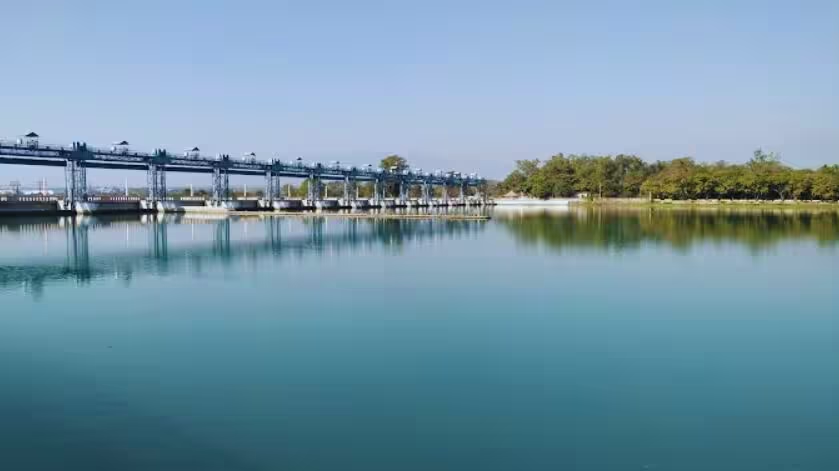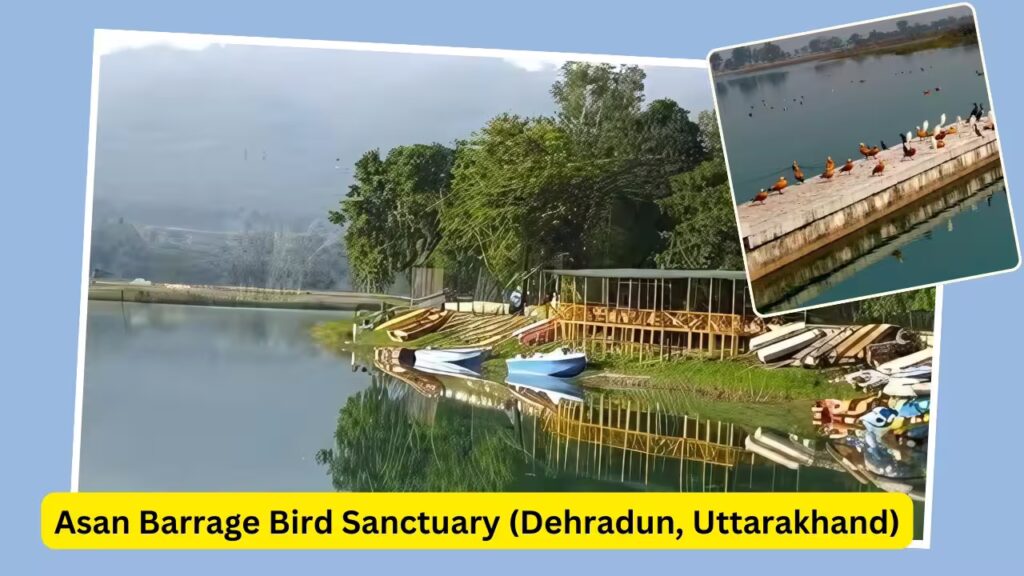The country of India is blessed with vast numbers of faunas and floras which signify a rich and beautiful biodiversity. This land of soil consists of several bird sanctuaries including Assan Barrage Bird Sanctuary, wildlife sanctuaries, bio-reserves, national parks, botanical gardens, and numerous other ones to go and explore. Take a tour to Assan Barrage Bird Sanctuary, which proves to be a shelter for birds, wildlife, flora, and vegetation.
An Overview of the Assan barrage Bird Sanctuary
Assan Barrage Bird Sanctuary, around 43 km from Dehradun, Uttarakhand, is an aesthetic place for birding sights for bird enthusiasts and nature lovers alike. The beautiful Assan Conservation Reserve or Barrage lies within blue-green waters where birding enthusiasts can be seen clicking the beautiful scenes of the place. This wetland is a paradise for birds of different kinds.
There you can see both local and migrant birds who migrate to the place from Central Asia and Europe. Popularly known as Dhalipur Lake, is stretched over silent waters and an alluring environment. The place is perfect for ornithologists, bird watchers, and curious travellers who want to experience and enjoy the beauty of nature.
Table of Contents
Where Assan Barrage Bird Sanctuary is located?
Assan Barrage is in Dehradun, Uttarakhand in the west at a distance of 43 km. Tourists can find it around the rivers Yamuna and Assan, which were a part of the damming project. It has an altitude of about 389 above sea level. This location is near to Paonta Sahib, one of the ‘Takhts’ of Sikhism, thus accessible by all. The barrage length is 287.5 m. The place is ideal for both local and migratory birds. It acts as one of the most important routes for the travelling migrants between Central Asia and the Indian subcontinent.
History of the Assan Barrage
In the year 1967, the Assan Barrage Bird Sanctuary was instituted to control the utilization of River Yamuna for irrigation purposes. Subsequently, the barrage created large wetland areas. It comes out as an attraction spot for local birds and migratory birds.
As soon as the birds started gathering at this place, the place became the eye for ornithologists and conversationalists. As the site is titled Bird Sanctuary, it is a big ecologically important one. It was the first conservation project of Uttarakhand.
The Assan Barrage later gained international recognition as it welcomes many birds from Central Asia, Siberia, and Europe, mostly in winter. The site protects several endangered and rare species, contributing to the biodiversity of the region.
why should you visit the Assan Barrage?

Assan Barrage Bird Sanctuary is a treasure trove of biodiversity, featuring many species. The location hosts a range of birds, wild animals, and flora. Local and migratory birds are available in the sanctuary which attracts many.
Flora
Since most of the Assan Barrage is a wetland, aquatic plant life dominates in this area. Common aquatic plants in this area, which you could see floating in the water, include Water Hyacinth, Lotus, Water Lily, Duckweed, Hydrilla, and Hornwort. The place is wet and consists of grass and sedges such as reed grass, common sedge, and typha, which can be found here. Some trees and shrubs have food for birds, shelters and nesting grounds like elsewhere in this area. Along with the Assan Barrage, one finds Jamun Tree whose fruit attracts birds, horny-tree Babul, and bamboo.
Chardham Package from ahmedabad – Book Your Tour with Travel Acharya
Fauna (birds and other wildlife)
The Assan Barrage Bird Sanctuary serves to be a home to more than 250 species of birds-both local and migratory birds. It is meant for serious bird enthusiasts who can closely observe and admire them. White-breasted kingfishers, black-crowned white herons, little egrets, and Indian cormorants are commonly spotted by visitors.
Migratory Birds: Siberian, European, and Central Asian migratory birds are welcomed in winter season by the sanctuary. Common teal, northern pintail, ruddy shelduck, and bar-headed goose flew and came here every year.
Endangered Species:
- Migratory birds which are rare and endangered such as white-rumped vultures and ospreys, visit here.
- Examples of local birds under this sanctuary are the red-crested pochard, great-spotted eagle, and Indian skimmer.
Other wildlife: Tourists can find here snakes, salamanders, tortoises, mongooses, jackals, domestic animals like cows, dogs, sheep and much more. Assan Barrage is home to all living creatures.
Birds that are Attraction to Assan Barrage Bird Sanctuary
Here is detailed information regarding the birds that live or visit in the Assan Barrage Bird Sanctuary:
- The Bird Sanctuary has recognized more than 250 species of birds.
- Form 53 species, 19 are migratory birds from Central Asia and Europe.
- 11 migratory bird species such as common teal, coot, Pintail, red-crested pochard, Brahminy duck, wigeon, tufted duck, gadwall, common pochard, shoveller and mallard, constitute 90% bird population in winter.
- The bird sanctuary lets in 10,000 birds in the winter, entitled as an important wetland for bird conservation in India.
| Local Bird Species | Migratory Bird Species | Endangered & Vulnerable Species | Waterfowl and others |
| Indian Cormorant, Little Egret, White-breasted Kingfisher, Black-crowned Night Heron, Pied Kingfisher, Purple Heron, Common Moorhen. | Bar-headed Goose, Ruddy Shelduck, Northern Pintail, Common Teal, Gadwall, Shoveler, Red-crested Pochard. | Indian Skimmer, Greater Spotted Eagle, Ferruginous Pochard, White-rumped Vulture, Osprey | Common Coot, Tufted Duck, Greylag Goose, Great Crested Grebe, Darter |
Ecological Importance
Let us learn about the ecological importance of Assan Barrage National Park:-
- Sojourn(stopover) for Migratory birds:
Assan Barrage is a major migratory route that provides shelter and food to the birds. The sanctuary is capable of feeding thousands of birds and ensuring stay in the winter season. These birds come from Eurasia and Siberia and help in the regulation of bird populations by giving them safe habitats.
- Biodiversity Hotspot:
The Assan Bird Sanctuary is home to over 250 Species which also includes endangered and vulnerable species. The sanctuary plays an important role in balancing ecological aspects and genetic diversity by sustaining these birds in their natural habitat.
- Wetland Ecosystem Services:
Managing water levels, filter pollutants, and recharging groundwater are merits of Ecosystem services of wetland. The Anas Barrage is capable of controlling floods and improving water quality.
- Dispersal of seeds and controlling pests:
The birds in the sanctuary help in growing plants around the area by dispersing seeds. These birds also help in the elimination of pests by eating these insects.
- Climate and decarbonization:
Assan wetlands can sink, absorb and store carbon dioxide emissions, which helps to prevent climate change. The sanctuary is capable of regulating climate conditions and assisting in reducing greenhouse effects.
Watch This Video To See How Assan Barrage Bird Sanctuary Looks
Assan Barrage Bird Sanctuary’s Difficulties & Strategy
Difficulties for the Sanctuary
The Assan Barrage Bird Sanctuary faces several challenges which may affect the area ecosystem, such as:
- The sanctuary faces major issues like water pollution which may caused by human activities, agriculture runoff and industrial waste disposal. This water is harmful to the living creatures and avians in the sanctuary.
- The sanctuary also faces the problem of exploitation of habitat because of unregulated tourists, urbanization and encroachment.
- Climate change is the reason for diverting routes of migratory birds.
- Poachers and hunters have endangered many bird species and put them on the list of vulnerabilities.
A Forward-Looking Strategy
Assan Barrage Bird Sanctuary has sheltered many birds, animals and vegetation, but the initial step is to protect the future of it. A strict conservation layout is required with strict regulations on pollution control.
There is a necessity to adhere to eco-friendly approaches within the Assan Barrage to preserve the wetland, and natural heritage. The authorities or government of Uttarakhand can initiate programs and events to boost tourism. This will encourage damage caused by the local people’s activities and more efforts to beautify and maintain the place will begin. Proper infrastructure and providing job opportunities will be beneficial for people around.
Also, there must be a proper system for conducting scientific research and monitoring migratory birds and the population visiting the sanctuary, which will help in framing conservation plans. NGOs, environmentalists and the government can collaborate to ensure the promotion of the sanctuary.
Finalisation
The Assan Barrage Bird Sanctuary is an important habitat for most species of birds, especially when the large flocks travel long distances, so the wetland’s ecosystem becomes their abode. Its ecological value is a biodiversity hotspot, a source of environmental balance, and a hub for scientific research and eco-tourism.
Though there are threats on issues of pollution, habitat loss, and climate change. Provided that conservation efforts, responsible tourism, and environmental protection become the routes taken care of.
After all, its preservation secures not only the fact that it will remain a haven for birds but also for nature lovers generally and for generations to come.
FAQS
Where you can find Assan Barrage Sanctuary?
Sanctuary is located in the state capital of Dehradun, Uttarakhand, in the west direction at 43 km between rivers Yamuna and Assan.
When to visit the Assan sanctuary?
You can visit the Assan sanctuary during winter from November to February, when migratory birds enter the sanctuary.
What birds you can see there?
There are more than 250 species of birds such as the Indian Cormorant, Little Egret, White-breasted Kingfisher, Black-crowned Night Heron, Common Coot, Tufted Duck, Greylag Goose etc.
What visitors can do in Assan Barrage Bird Sanctuary?
Visitors can do bird-watching, photography, boating, exploring wetlands and guided tours.
Explore Other Beautiful Destination Like Assan Barrage Bird Sanctuary Below :
- Khirsu Hill Station Hotels, complete detail
- Tehri Lake travel guide
- Chardham Yatra 2024 full detail
- Roopkund Lake Trek history and other detail
- Panch Badri Yatra travel guide
- Complete detail about panch Kedar Yatra
- Joshimath travel tips
- Mussoorie, Uttarakhand travel guide
- Gaumukh Ganga complete detail
- Gaurikund complete detail
- Kausani: The Mini Switzerland Of India
- Munsiyari Hill Station travel guide
- Nanakmatta complete details
- Pithoragarh travel tips
- Plan Your Spiritual Journey complete detail
- Kasar Devi Temple history and other detail





